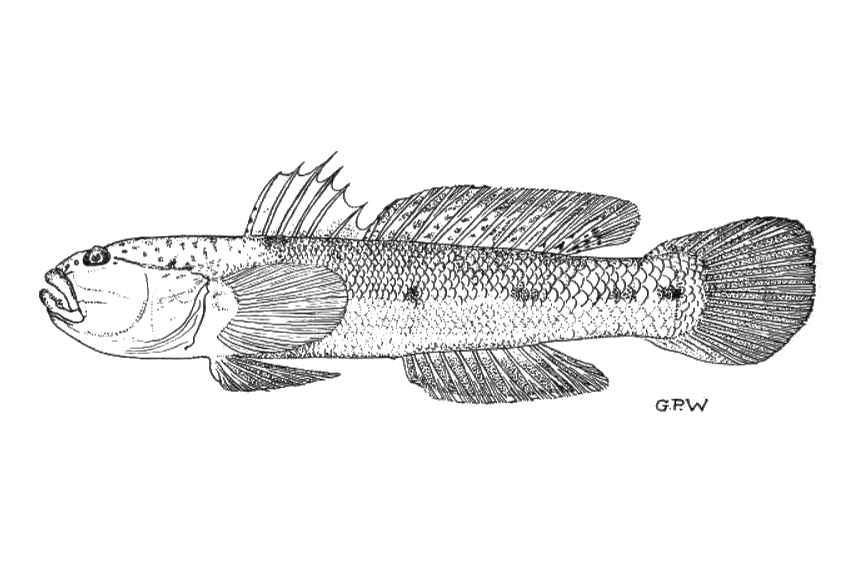Fire-eye Goby, Yoga pyrops (Whitley 1954)

Illustration of the holotype of Yoga pyrops. Source: Gilbert Whitley, Fig. 4 in Whitley (1954) Proc Roy Zool Soc NSW 1952–53: 23-30 figs 1-5 / Biodiversity heritage Library. License: CC BY Attribution
Cite this page as:
Bray, D.J. 2021, Yoga pyrops in Fishes of Australia, accessed 27 Jun 2025, https://fishesofaustralia.net.au/Home/species/183
Fire-eye Goby, Yoga pyrops (Whitley 1954)
More Info
|
Distribution |
Endemic to northern Australia from Darwin, Northern Territory, to Clearview, north of Rockhampton, Queensland. |
|
Features |
From the original description: Dorsal fin VI,12; Anal fin 11; Pectoral fin 16; Pelvic fin I,5; Caudal fin 13 main rays. No predorsal scales (except in young). Head (21mm.) 3.7, depth (16) 4.9, breadth of body (12) 6.5 in standard length (78). Eye, 4mm; snout, 6; postorbital, 12; interorbital, 3.2; depth of caudal peduncle, 10; depth of gill-opening, 11; predorsal length, 24. No ocular tentacle or nuchal crest, barbels or fleshy flaps. Head rather tumid and bulbous; profile convex. Head, pectoral base and much of breast naked. Rows of minute genipores. Upper lip exposed; lower jaw slightly jutting; tip of maxillary ensheathed; mouth barely reaching below front of eye, not opening widely. Teeth of both jaws in several rows, the outer of which is enlarged with conic teeth, largest anteriorly and halfway along sides of lower jaw where the canines cease. Tongue rounded, not notched. Interorbital tumid, with one central pore, followed by another in the median line. Anterior nostril with short tube. Groove from eye to top of opercle. Chin transversely folded. Eyes mostly in anterior third of head, pyriform, apex towards interorbital. Isthmus broad. Form rather rounded in transverse section and slightly compressed. Scales ctenoid. Anal papilla small. Dorsal spines slender, the sixth separated from the group of the first five, third longest (14mm). Dorsal bases contiguous. Anal rays fringed. No silky pectoral rays. Pelvics not reaching vent. Caudal irregularly rounded, shorter than head. |
|
Colour |
In formalin, pale yellow with indistinct small light brown patches along back (six double patches each side of dorsal fins) and along midline of sides. A few short grey bars on opercle, which has a diffuse blue patch. Eye blue. Dorsal with brown spots and flecks; few dark spots on first dorsal spine. Anal infuscated (tinged) brown, with pink margin. Fins mostly pale. The smaller Australian Museum paratypes have five conspicuous dark blotches along middle of each side; the posterior dorsal and upper caudal rays are dark-spotted. |
|
Etymology |
The specific name pyrops is from the Latin pirum (= pear) and the Greek ops (= eye), in reference to the pear-shaped or "pyriform" eyes of this species. |
|
Species Citation |
Ctenogobius (Yoga) pyrops Whitley 1954, Proc. Roy. Zool. Soc. N. S. W. 1952–53: 26, fig. 4. Type locality: Karumba, Queensland. |
|
Author |
Bray, D.J. 2021 |
|
Resources |
Fire-eye Goby, Yoga pyrops (Whitley 1954)
References
Larson, H.K. & Murdy, E.O. 2001. Eleotridae, Gobiidae. pp. 3574-3604 in Carpenter, K.E. & Niem, T.H. (eds). The Living Marine Resources of the Western Central Pacific. FAO Species Identification Guide for Fisheries Purposes. Rome : FAO Vol. 6 pp. 3381-4218. (as Acentrogobius pyrops)
Whitley, G.P. 1954. New locality records for some Australian fishes. Proceedings of the Royal Zoological Society of New South Wales 1952–53: 23-30 figs See ref at BHL


